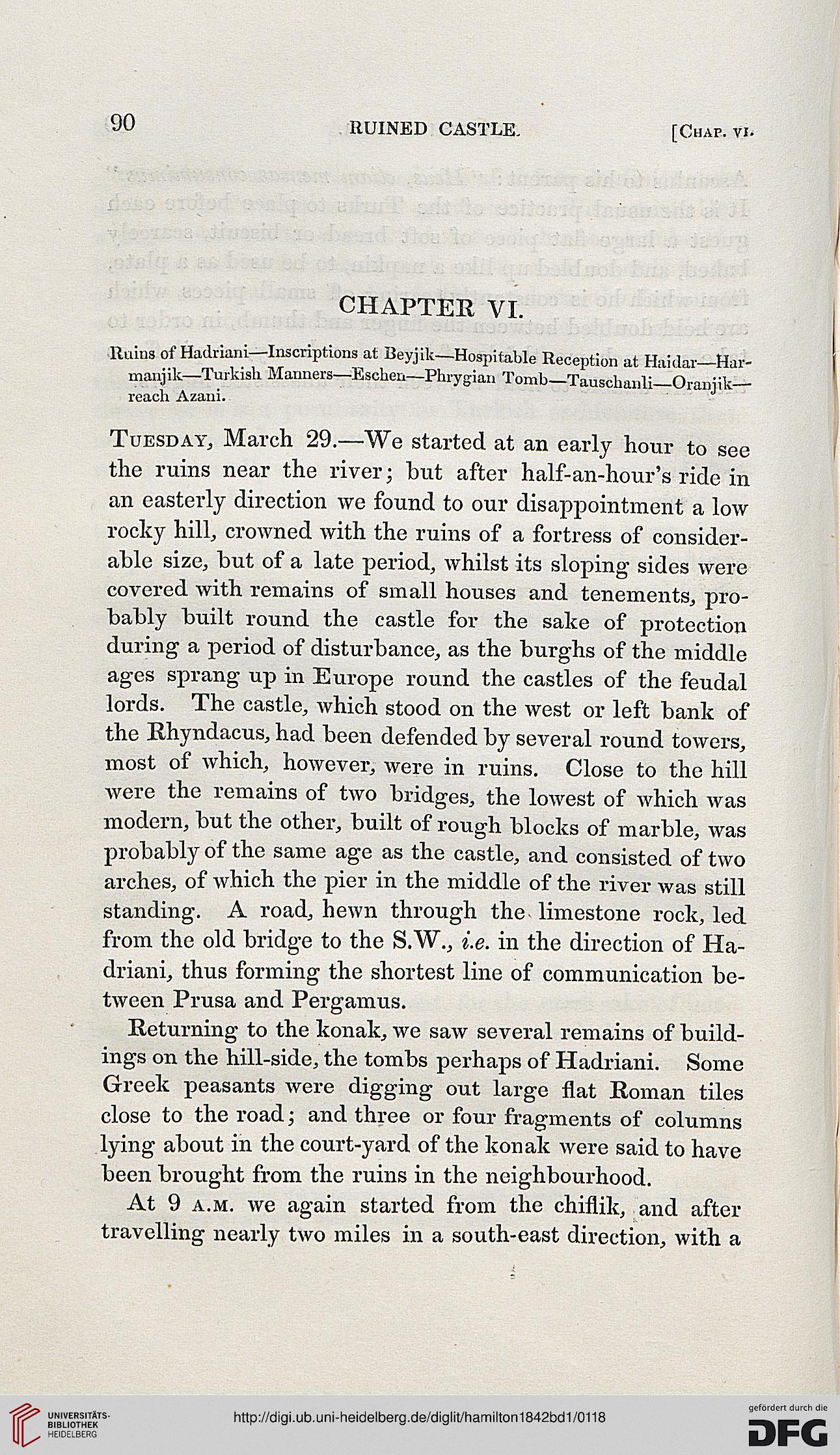90
RUINED CASTLE.
[Chap, vi.
CHAPTER VI.
Ruins of Hadriani—Inscriptions at Beyjik—Hospitable Reception at Haidar—Har-
manj ik—Turkish Manners—Eschen—Phrygian Tomb—Tauschanli_Oranjik—
reach Azani.
Tuesday, March 29.—We started at an early hour to see
the ruins near the river; but after half-an-hour's ride in
an easterly direction we found to our disappointment a low
rocky hill, crowned with the ruins of a fortress of consider-
able size, but of a late period, whilst its sloping sides were
covered with remains of small houses and tenements, pro-
bably built round the castle for the sake of protection
during a period of disturbance, as the burghs of the middle
ages sprang up in Europe round the castles of the feudal
lords. The castle, which stood on the west or left bank of
the Rhyndacus, had been defended by several round towers,
most of which, however, were in ruins. Close to the hill
were the remains of two bridges, the lowest of which was
modern, but the other, built of rough blocks of marble, was
probably of the same age as the castle, and consisted of two
arches, of which the pier in the middle of the river was still
standing. A road, hewn through the limestone rock, led
from the old bridge to the S.W., i.e. in the direction of Ha-
driani, thus forming the shortest line of communication be-
tween Prusa and Pergamus.
Returning to the konak, we saw several remains of build-
ings on the hill-side, the tombs perhaps of Hadriani. Some
Greek peasants were digging out large flat Roman tiles
close to the road; and three or four fragments of columns
lying about in the court-yard of the konak were said to have
been brought from the ruins in the neighbourhood.
At 9 a.m. we again started from the chiflik, and after
travelling nearly two miles in a south-east direction, with a
RUINED CASTLE.
[Chap, vi.
CHAPTER VI.
Ruins of Hadriani—Inscriptions at Beyjik—Hospitable Reception at Haidar—Har-
manj ik—Turkish Manners—Eschen—Phrygian Tomb—Tauschanli_Oranjik—
reach Azani.
Tuesday, March 29.—We started at an early hour to see
the ruins near the river; but after half-an-hour's ride in
an easterly direction we found to our disappointment a low
rocky hill, crowned with the ruins of a fortress of consider-
able size, but of a late period, whilst its sloping sides were
covered with remains of small houses and tenements, pro-
bably built round the castle for the sake of protection
during a period of disturbance, as the burghs of the middle
ages sprang up in Europe round the castles of the feudal
lords. The castle, which stood on the west or left bank of
the Rhyndacus, had been defended by several round towers,
most of which, however, were in ruins. Close to the hill
were the remains of two bridges, the lowest of which was
modern, but the other, built of rough blocks of marble, was
probably of the same age as the castle, and consisted of two
arches, of which the pier in the middle of the river was still
standing. A road, hewn through the limestone rock, led
from the old bridge to the S.W., i.e. in the direction of Ha-
driani, thus forming the shortest line of communication be-
tween Prusa and Pergamus.
Returning to the konak, we saw several remains of build-
ings on the hill-side, the tombs perhaps of Hadriani. Some
Greek peasants were digging out large flat Roman tiles
close to the road; and three or four fragments of columns
lying about in the court-yard of the konak were said to have
been brought from the ruins in the neighbourhood.
At 9 a.m. we again started from the chiflik, and after
travelling nearly two miles in a south-east direction, with a




